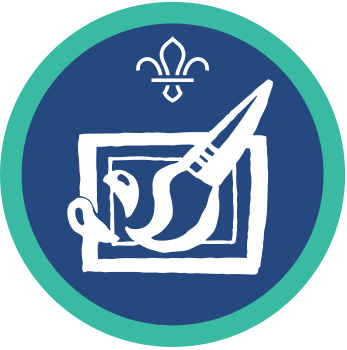
Make Pride spoon puppets
You’ll need
- Wooden spoons
- A4 card
- Pens or pencils
- Coloured pens or pencils
- Cotton wool balls
- Paint
- Paint brushes
- Craft materials (for example, tissue paper, pipe cleaners, stickers)
- PVA glue
- Googly eyes
- Pipe cleaners
- String
- Self-adhesive felt sheets
- Fabric
- Printed information about some LGBTQ+ legends (optional)
Before you begin
- Use the safety checklist to help you plan and risk assess your activity. There's also more guidance to help you carry out your risk assessment, including examples. Don’t forget to make sure all young people and adults involved in the activity know how to take part safely.
- Make sure you’ll have enough adult helpers. You may need some parents and carers to help if you’re short on helpers.
Planning this activity
- You can find some ideas of LGBTQ+ legends on this page. You could have a selection of printouts about different inspiring people for young people to choose from and learn more about.
- Some people may be in the process of questioning their sexual orientation or gender identity or may not have shared their identity with anyone. Make sure everyone knows they don’t have to share anything about themselves if they don’t want to. It’s important that everyone feels comfortable in this activity, as well as knowing how they can access support.
- Young people may share aspects of their identity that may be new to them, new to you or new to the rest of your group. This is a very brave thing to do, and it's extremely personal and different for everyone. Make sure you look out for these individuals and provide a safe and calm space for them to process their emotions. Make sure to model affirming responses to anything shared by your young people.
- There's a range of labels young people and adult volunteers may use to describe their sexual orientation or gender identity. For example, asexual, pansexual, nonbinary, or questioning. Take the time to research these, so you feel comfortable in your knowledge of them should a young person or adult want to discuss their sexual orientation or gender identity with you.
- It's the responsibility of all adults in Scouts to help develop a caring and supportive atmosphere where bullying in any form is unacceptable. Look out for any signs of homophobic and/or transphobic bullying and language. See our guidance on preventing and dealing with bullying. You may want to create a zero-tolerance policy towards LGBTQ+ bulling or discrimination within your Section or Group rules.
- You may want to visit our LGBTQ+ pages to find out more about supporting LGBTQ+ members in Scouts.
You could create lots of different LGBTQ+ legends, including historical, fictional or modern figures. You may also create someone you know. Some ideas include:
- JoJo Siwa
- Tom Daley
- Graham Norton
- Sir Ian McKellen
- Frida Kahlo
- Elton John
- Freddie Mercury
- George Michael
- Lady Gaga
- Ru Paul
- Kit Connor
- Rebel Wilson
- Miriam Margolyes
- Joe Lycett
- Tan France
- Adam Lambert
- Alan Carr
- Russell Tovey
- Lil Nas X
- James Baldwin
- Ncuti Gatwa
- Andrew Scott
- Cara Delevingne
- Neil Patrick Harris
- Alan Turing
- Marsha P Johnson
- Sylvia Rivera
- Audre Lorde
- Keith Haring
- Lou Sullivan
- ND Stevenson
- Sam Smith
- Paul O’Grady
- Stephen Fry
- Kelly Holmes
- Laverne Cox
- Elliot Page
- Jim Parsons
- Hannah Gadsby
- Miley Cyrus
- Janelle Monáe
Some ideas for hair include:
- String
- Self-adhesive felt sheets
- Cotton wool
- Pipe cleaners.
Some ideas for a face include:
- Paint
- Permanent markers
- Stickers
- Googly eyes
- Art deco pens
- Self-adhesive felt sheets
- Fabric
- Felt tips
Some ideas for ears, crowns, glasses or other accessories include:
- Pom poms (great for noses!)
- Self-adhesive felt sheets
- Biodegradable glitter
- Fabric
- Stickers
- Buttons
- Ribbon
- Pipe cleaners
- Sequins
- Card
Some ideas for the arms include:
- Pipe cleaners
- Card
Setting up this activity
- You may want to set up tables, chairs and craft materials before starting the session.
Introducing the activity
- Gather everyone in a circle. Tell everyone that today they’re making a spoon puppet of an LGBTQ+ person who has inspired them or changed the world in some way. It could be a person in their lives, in history, in fiction or a celebrity. It could be a local person, too.
- You could tell people in advance of the session and give everyone the chance to do some research about who they’re making and why or what they’ve done.
- Give everyone a few minutes to think of someone. If you’ve a selection of printouts about different inspiring people, let young people have a chance to look through them.
- Go round in a circle and ask people to say the brilliant, inspirational person they want to make a spoon puppet of. If people don’t want to say who they’ve chosen, that’s OK too.
- Now, ask everyone to take a spoon and get ready to draw their design.
Run the activity
- Everyone should take a spoon and draw their design on in pencil.
- First, they could paint the handle of the wooden spoon and leave to dry.
- Once the paint is completely dry write the name of the person down the handle of the spoon, using an art deco pen, permanent marker or in paint.
- Everyone should then use the craft materials to create their person. They might want to give the person different features and use glue to attach the items. Before using glue, make sure any paint is dry. This means the glue and paint shouldn’t mix.
- If people want to make an outfit, they could cut the outfit’s shape out of a sheet of felt, fabric, card, or another material. This should be stuck on the front of the spoon. The outfit can then be re-cut out of the same fabric, and you can attach it to the back of the handle using double sided tape to a full outfit. You can also glue or stick the back of the outfit to the front of the outfit, so it wraps around the spoon.
- Encourage and allow people to be as creative as possible in their designs.
- Once everyone’s finished, leave the spoon puppets to dry.
- You could go round in a circle and ask everyone to show who their spoon is, why they chose that person, what they did and how they inspire them. They don’t need to share this if they don’t feel comfortable doing so.
Reflection
This activity was all about finding out about LGBTQ+ people who inspire us. Who did you create? Why did you choose that person? What did they do and how do they inspire you?
If you could say one thing to that person or meet them, what would you say? How have they impacted people? Why do you think they need to be celebrated? How have they supported the LGBTQ+ community? What might they have done to improve the lives of LGBTQ+ people?
We made puppets to help bring our inspiring people to life. What did you do to make your puppet? How did you think creatively to turn the spoon into a puppet of the person?
Make a craft can sometimes be harder than we first thought. It can be useful to plan. Did you plan or draw what you’d make before you started? Did you run into any difficulties and how did you resolve them? What do you think of your puppet? What did you like and is there anything you’d change or amend?
Safety
All activities must be safely managed. You must complete a thorough risk assessment and take appropriate steps to reduce risk. Use the safety checklist to help you plan and risk assess your activity. Always get approval for the activity, and have suitable supervision and an InTouch process.
- Glue and solvents
Always supervise young people appropriately when they’re using glue and solvent products. Make sure there’s plenty of ventilation. Be aware of any medical conditions that could be affected by glue or solvent use and make adjustments as needed.
- Rubbish and recycling
All items should be clean and suitable for this activity.
- You could make some examples or have pre-cut items to make it easier. You could also use smaller, cutlery sized wooden spoons, rather than kitchen/utensil sized wooden spoons.
- If anyone needs help or struggles with fine motor skills, give them the opportunity to work in pairs, with a young leader or an adult volunteer. Alternatively, swap out the items for something easier to handle.
- People who struggle with making choices could find all the options a bit overwhelming, so they might need extra support or to work with a young leader or volunteer to be able to create their artwork.
- If anyone needs support in using craft items, allow them to work with someone else who can help them.
All Scout activities should be inclusive and accessible.
You could put on a show with your puppet spoons for each other, another group or for parents and carers.
Encourage and allow people to be as creative as possible in their designs. They can suggest who they’d like to design.

